feature
Data at a Distance
Innovative Science Experiments Using the Internet of Things
The Science Teacher—January/February 2022 (Volume 89, Issue 3)
By Seth Van Doren, Lisa Hardy, Colin Dixon, and Sherry Hsi
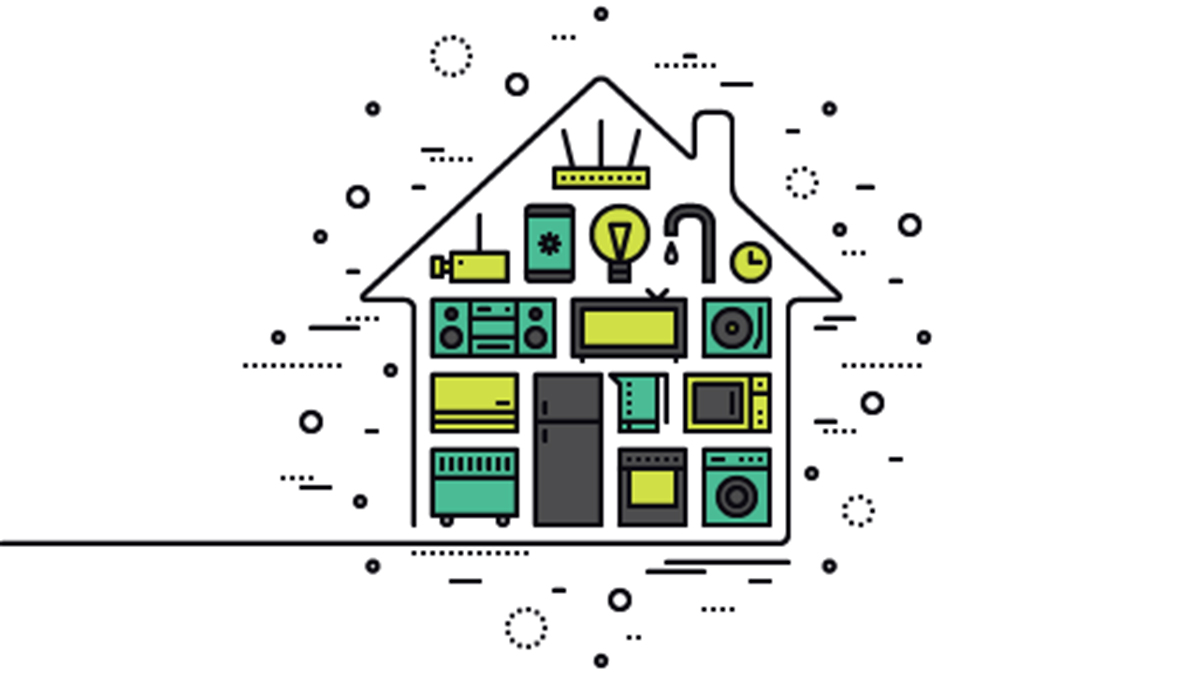
Long before the Next Generation Science Standards (NGSS) were formalized, sensors and other probeware engaged students in science and engineering practices (Metcalf and Tinker 2004). A new generation of probeware based on modern Internet of Things (IoT) technologies is beginning to expand the ways that students can collaborate and conduct scientific investigations (Bondaryk, Hsi, and Van Doren 2021). Just as modern scientists work on teams spread around the globe, making use of large-scale, distributed sensor networks to generate geographic and environmental data (Fang et al. 2014) or monitor and manage laboratory equipment over a distance (Perkel 2017), students’ sensor-based lab experiences no longer need to be tied down to a computer in a classroom. With IoT, data-driven investigations can happen both in and out of schools, and everywhere in between. This is particularly important when teaching at school isn’t an option. As we have seen, wildfires, natural disasters, severe weather, pandemics, and infrastructure failures can force long-term emptying of school sites, but teachers and students using IoT systems can continue to do science together, even if they are physically apart.
Internet of Things
The Internet of Things is a new generation of devices (“things”) that communicate constantly over the internet. You may already have IoT devices in your home—smart thermostats or coffee machines that automatically order more coffee beans when you’re almost out. There are two main types of IoT device: sensors that monitor and create data about the environment, and actuators that can do things, like turn on a light or fan. Sensors send their data to the cloud to be processed by software, and based on that data, the software then tells the actuators what to do. The ability to operate without direct human-device interaction means that anyone using an IoT system can remotely collect data and program automated responses from other parts of the system. Some IoT systems include a user interface, where people can view the data or modify the programs that process it. Scientists in various fields have begun to utilize IoT technologies.
InSPECT
Integrated Science Practices Enhanced by Computational Thinking (InSPECT) is a NSF-supported project leveraging IoT to build the next generation of tools for classroom science. Currently, the InSPECT hardware kit (Figure 1) includes programmable relays, CO2, light, O2, temperature, and humidity sensors. Up to six devices can be connected to a central hub that wirelessly connects to the internet and transmits data to the cloud. InSPECT’s software, Dataflow (Figure 2), is an online platform for processing and graphing streams of real-time sensor data. Students using Dataflow are able to control their data through its lifecycle. They can make decisions about what data to collect, how to modify or transform that data, if that data will be used to actuate a relay, how to store data, and how to view data.
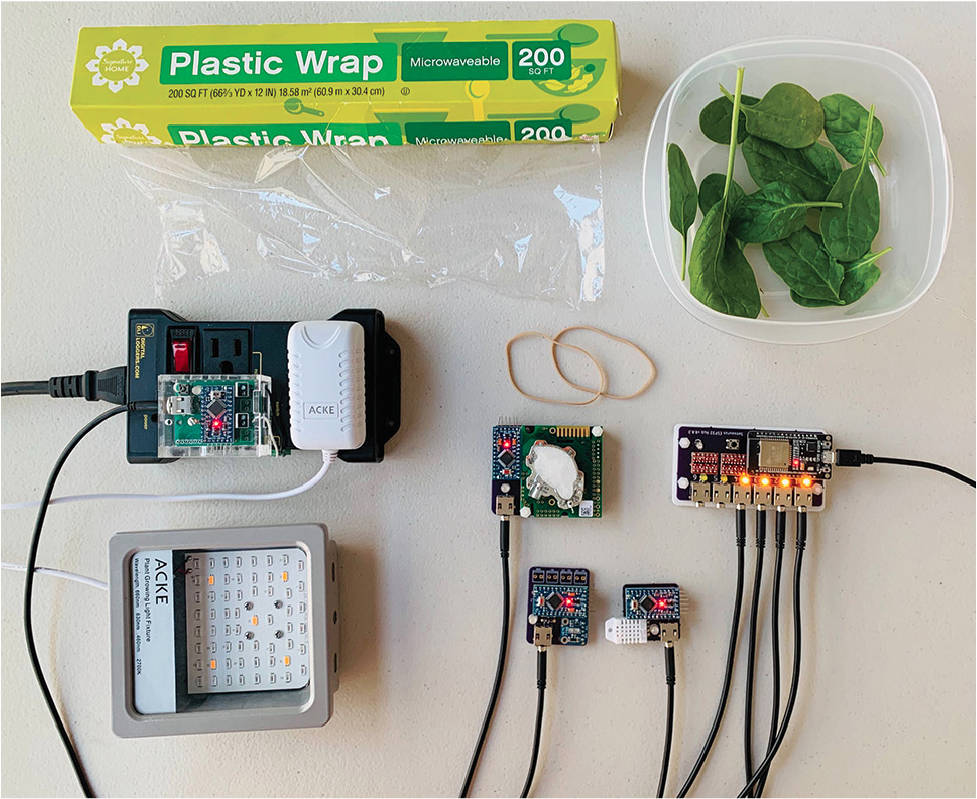
IoT hardware kit.
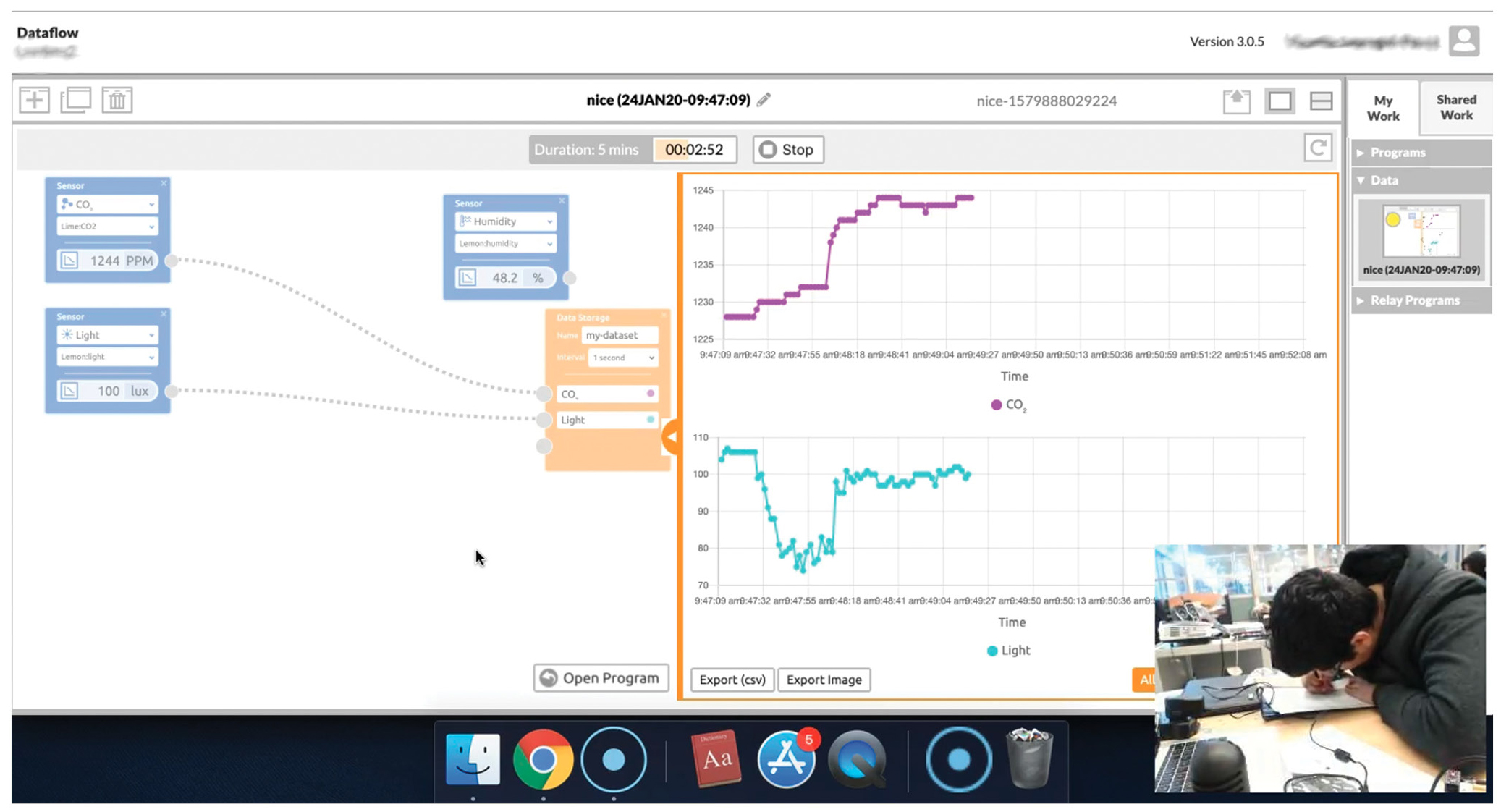
Dataflow software used to design investigations and program IoT hardware.
Giving students the freedom to mix and match components expands the number of investigations they can pursue. For example, one student connected multiple CO2 sensors to the same hub to check for variance between the individual sensors, while another used three CO2 sensors to simultaneously monitor gas levels in three different systems.
The InSPECT curriculum is a seven-lesson arc of activities engaging high school biology students in authentic science investigations that they themselves design. To encourage student thinking about data and data collection, we first give them graphs of CO2 and light levels collected from their own classroom and present the sensor kit used to produce the graph. We show them some current research that suggests CO2 levels over ~1000ppm are unhealthy. Students are asked to find times when the levels in their own classroom may have become unhealthy, and also to look for interesting features in the data that they can explain using knowledge of their school—when a janitor came into the room or when the teacher left for the day. We use this graph as a starting point to discuss CO2 levels in the classroom and begin asking questions like: What produces CO2? Does anything consume it? What can we do to keep levels healthy? How can we use a network of sensors to address the problem of unhealthy CO2 levels?
Next, students collect their own data, monitor the classroom CO2 levels, and learn to set up the InSPECT hardware and software. Some students use the provided instruction sheets when getting started, but many students enjoy figuring things out on their own and developing their own understanding of the InSPECT kit. As a class, we discuss the variation in measurements and what causes them (e.g., the sensors themselves, measurement noise, or variation in the actual CO2 levels). Students then use the InSPECT relays and write a program to turn on a lamp to automatically notify us when classroom CO2 levels rise over 1000ppm and become unhealthy.
Returning to the question of what is affecting the CO2 levels, the class brainstorms a list of things that we think affect CO2 levels on a global scale. Students identify producers and consumers of CO2, such as trees, factories, or cars. We generate ideas for a question board: Why do factories, cars, and humans produce CO2? Are they doing the same thing somehow? What do we know about plants and how they affect CO2? Does light have something to do with that? In small groups, students then plan how they could use the sensors to figure out how light affects plants’ consumption of CO2. They spend the next class periods performing investigations related to photosynthesis and cellular respiration in plants and animals, challenging themselves to plan their own investigations and collect the data that helps develop their understanding of key biology content learning goals.
Unlike traditional “cookbook” labs with rigid procedures that usher students along to predetermined conclusions, activities in the InSPECT curriculum are designed to allow students to create their own methods and construct their own understanding. The main objectives of the curriculum are to create opportunities for students to build conceptual models of photosynthesis and cellular respiration, and to use those models to explain changes in atmospheric CO2 levels, both in the classroom and globally.
At the same time, students learn to use sensors, actuators, and software to produce data, respond to changing environmental conditions, and control experimental variables. IoT systems both broaden the variety of investigations that students can do, and can help students understand how modern computational tools work and are used in scientific investigations.
IoT systems improve on traditional probeware by more deeply engaging students in the NGSS science and engineering practices of Using Mathematical and Computational Thinking, Analyzing and Interpreting Data, and Obtaining, Evaluating, and Communicating Information (NGSS Lead States 2013). InSPECT classes have seen significant learning gains based on performance on formative and summative assessments that tested both biology and computational content knowledge. For example, in the group of 74 students who completed the curriculum described above, including both pre- and post-assessments, we saw an average 25% increase in scores.
Insights from an InSPECT classroom
When we observed a second-year teacher, Ms. W., at a public San Francisco Bay Area high school using InSPECT in their ninth-grade biology class, we came away with three key insights into how IoT systems could change science classrooms:
1. IoT offers new ways to learn about the world
With IoT systems, students can learn about phenomena happening at the same time in different locations. In one InSPECT activity, students use IoT CO2 sensors to investigate the CO2 concentration in their classroom. They are able to view and create data sets in Dataflow using their sensor data and they can access and collect other groups’ data. After different groups reported significantly different CO2 concentrations, students were asked to consider the reasons why so many different values were reported; they suggested factors that could influence ambient CO2 concentration at each group. Since students can interact with the entire network of sensors, one group of students did a “Sensor Spies” activity in which they logged into their user interface and took on the challenge of guessing who is operating each sensor based on that sensor’s output. IoT activities not only give students opportunities to think about new ways of collecting scientific data, but could also be used to spark serious and important conversations about data privacy and other issues related to public sensor data.
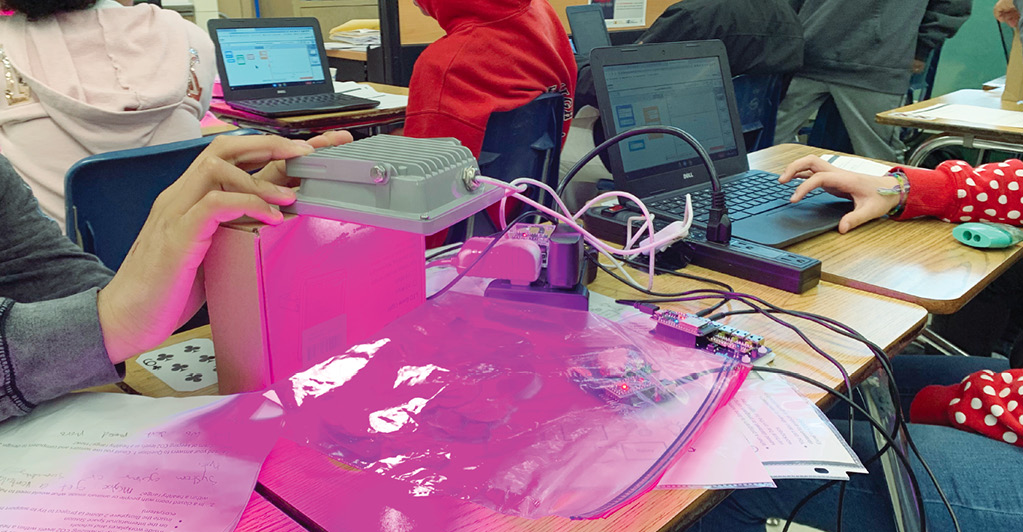
Students tinkering during a lab to produce data from plants.
2. Technology unleashes student curiosity and creativity
An open-ended curriculum that encourages student agency makes room for students to engage with technology in creative ways. During a “free play” day at the end of the main InSPECT curriculum, one student, Riley, used the IoT devices to build a “Rube-Goldberg” system. A rising carbon dioxide level would first turn on a lamp on one side of the student’s desk. The changing light level would be detected by a light sensor, which would then trigger a second lamp on the other side of the desk. Riley, a self-described tinkerer who was re-taking biology, was more engaged working on this project than in any of the previous science investigations. While Riley had earlier become frustrated when difficulties arose in using the technology for the earlier experiments, in this independent project he persisted through malfunctions and persevered in troubleshooting. And when Riley’s system began to exhibit its own behavior by automatically cycling itself on and off, instead of becoming frustrated, the strange behavior instead deepened Riley’s interest and engagement.
While this unique IoT system existed in a single classroom, students could construct similar systems that span combinations of classrooms, schools, and households. For instance, a sensor in Jacob’s house could be used to turn off a lamp in Brenna’s house. And if the “chain reaction” doesn’t work as expected, students could identify where things went wrong and work together to fix any bugs or design errors.
Interviews with students also helped shed light on how IoT systems can help elicit creative student ideas about what they could achieve with technology. When asked about what they would like to control with a relay outside of school, Pierre said “I had this idea of creating robots that would automatically plant trees.” When asked to elaborate, Pierre responded, “I’ll use a sensor to find out more about the place that I’m going to plant the trees, and find the right trees to plant there... I’ll just get a robot that would shoot seeds at the ground and water them automatically… So I would keep the sensor out for one month and then track the data of the highest point and then the lowest, and then the most stable to find the trees that would like that sort of temperature.”
When students become comfortable using IoT systems and can imagine their uses, they have the opportunity to connect science class to the world and envision themselves making meaningful differences.
3. Learning takes place in and out of the classroom
Having the ability to learn across a variety of settings is an important aspect of an IoT learning environment. Students have used their personal devices to log into Dataflow to check on their data collection and create programs. One important advantage of IoT systems is that they can be designed to be operated from personal devices, at school or home, and not just from expensive, proprietary user interfaces. Since computing and data storage can be done in the cloud, IoT systems can be used from inexpensive devices with low computing power and storage space, like Chromebooks, tablets, and smartphones.
Access to computers and home wireless internet networks can be a serious concern for both students and teachers, particularly when teachers and students cannot meet in school. IoT systems can help alleviate that concern and improve accessibility by being compatible with devices people already own, and providing greater flexibility with how and where to connect to the internet. Students can operate like a remote research team, producing and sharing data they are interested in from places they are connected to. They can learn from their classmates’ insights while working toward a better understanding of technology and key science concepts at the same time.
Implementing IoT systems
While there are many advantages to using IoT systems during instruction, they can be challenging to implement, and teachers must be prepared to take on the dual roles of educator and technical support. To fully utilize IoT systems, teachers will need to lead discussions about new phenomena as students produce data in real time, create new learning opportunities that allow students to showcase their creativity while learning about modern technology and science, and orchestrate learning across various in- or out-of-school settings.
It’s important to shift agency toward students working with IoT systems. Ms. W., who used InSPECT in both her first- and second-year teaching, tried different scaffolding methods each year. During the first year, most scaffolding was provided on slides that included robust and timely instructions. The second year, scaffolding was provided on worksheets and tip sheets that contained information about how to set up the hardware and software as well as what data to produce. This second method helped the teacher spend more time interacting with groups of students and less time managing the slide show. Students were trusted to work at their own pace. They didn’t rely on the teacher to reveal instructions, activity prompts, or questions. An example of a scaffolded worksheet filled out by a ninth-grade student can be seen in Figure 4.
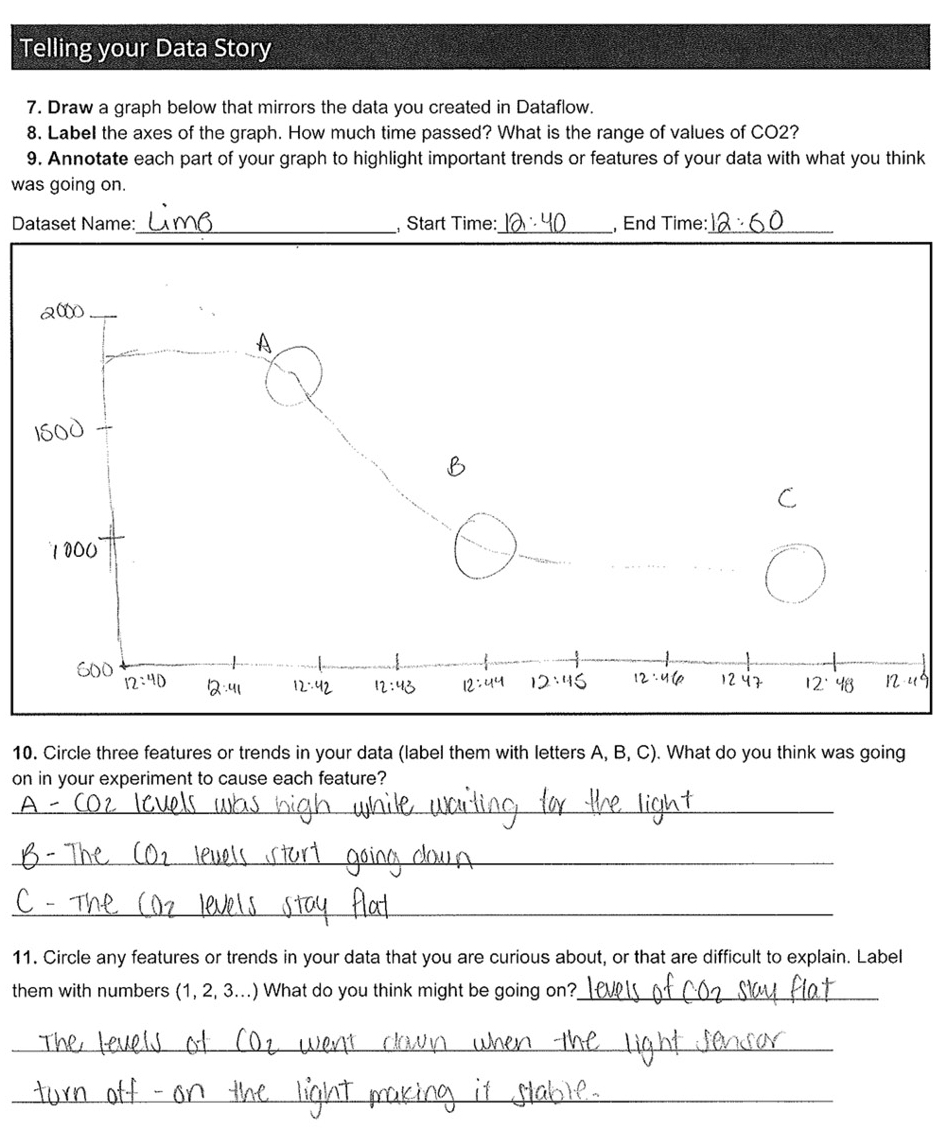
Student worksheet.
We recommend that work with IoT systems be coupled with student-led discussions about data, data production, and target science content. To start, students can discuss their methods and their plans, and learn from each other in small groups. At formative points in the curriculum and during a summary, teachers can use student-produced data to facilitate full-group conversations to interpret data and connect trends to broader learning goals.
Ms. W. knew the importance of student-led discussions, but didn’t think they had yet built a classroom culture where those kinds of discussions can be sustained. Saying, “I’d say that’s probably the biggest hole, I think it would be useful to have some more places for student-mediated sensemaking talk. But this is also something where, depending on your classroom, it can be possible or it could be impossible. I don’t think I am very capable of handling those discussions yet. That takes a lot of classroom culture building, and it can be very challenging to build that classroom culture with some students.”
A fourth-year teacher using InSPECT in their ninth-grade biology classroom, Ms. T., was able to elicit student ideas through student-led discussions by asking students to share “data stories” with their class after completing a cellular respiration lab. They asked a student to share an interesting data set with the class, and then had students discuss the data set in small groups. The groups compared the data set with their own and brainstormed ideas about why the dataset looks like it does, for example, by guessing when variables like light or temperature were changed. If the data set was peculiar and had an abnormal spike on an otherwise smooth data set, students would brainstorm factors that could have caused the anomaly.
Following the small group discussions, Ms. T. brought the whole class back together to discuss their observations and findings, asking them to back up their claims using the data they produced in their own experiments, while the class worked toward a shared understanding of cellular respiration. These conversations also served as informal assessments, allowing Ms. T. to gauge student understanding and discover commonly held misconceptions.
Differentiation
One of the benefits of combining IoT sensors and open-ended curriculum is that students have the freedom to work toward goals in ways that cater to their personal interests. For example, a student who enjoys programming could construct a program that uses a relay to control light levels over their container of spinach. Successful teachers will encourage their students to take up methods that best suit their personal learning styles.
Safety
Students will need to safely connect components to power sources. It could be beneficial to discuss safe outlet practices with students. Only GFI-protected circuits are to be used for electrical equipment and make sure students keep away from water or other liquid sources to prevent electrical shock. Students also should not touch power cable prongs, given the risk of electrical shock.
Conclusion
We are encouraged by the results of the InSPECT project and believe that IoT systems paired with open-ended NGSS-aligned curricula can create opportunities for students to engage in more modern science investigations that take place in teams across various settings and make use of internet-connected sensor networks. While there are challenges involved—from technical troubleshooting to leading complex discussions and orchestrating learning across multiple settings—the results for science learning could truly be transformative, creating unique opportunities for student creativity, scientific collaboration at a distance, and important discussions about data and technology use in the 21st century.
Seth Van Doren (svandoren@bscs.org) is Research Project Manager at BSCS Science Learning, Colorado Springs, CO. Lisa Hardy (lhardy@concord.org) is a Research Associate at the Concord Consortium, Emeryville, CA. Colin Dixon is a Research Scientist and Sherry Hsi is a Principal Scientist at BSCS Science Learning, Colorado Springs, CO.
Biology Labs Pedagogy Research Science and Engineering Practices High School


